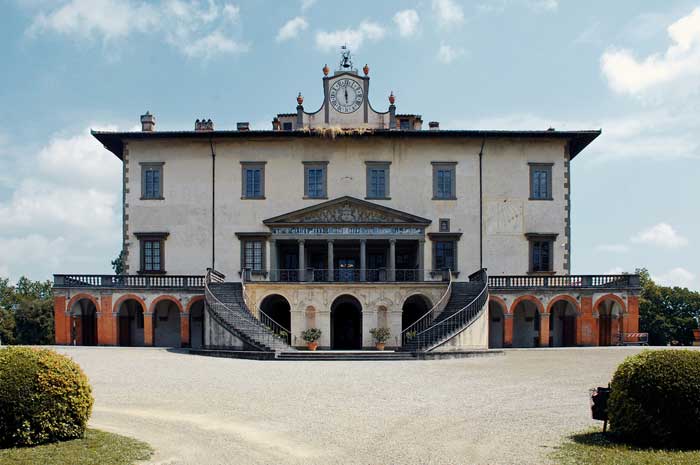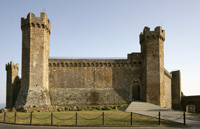| |
|
This Grand Ducal villa is situated on a hill on the shores of the river Ombrone and is one of the most beautiful in Tuscany. The building of the villa was almost entirely due to Laurence the Magnificent whoo built the Medici Villa on the site of an ancient castle which once belonged to the powerful Cancellieri family of Pistoia. After 1420 it was bought by the Strozzi and finally by the Medici.
RThe villa at Poggio a Caiano always remained the summer residence of the Medici, and, other than hosting numerous notable personalities, it was a stage for the important events in their history, such as the weddings of Alessandro dè Medici and Margherita d'Austria (1536), Cosimo I and Eleonora da Toledo (1539)[5], and that of Francesco I and his lover Bianca Cappello (1579).
Poggio a Caiano is located at the intersection of straight lines from Florence to the city of Pistoia, and from the city of Prato and to Montalbano. Poggio a Caiano lies 9 km south of the provincial capital of Prato.
From the hill that gives the town its name there is a fine view over the plain of the Ombrone and Bisenzio rivers toward Prato to the north and Florence to the east, and over the lowlands leading to Pistoia and the Appenine mountains.
It was not by accident that Lorenzo de' Medici chose this site to build his Villa, the building which is still the most dominant in the town, to the point that the one is always identified by the other.
The Villa Medicea at Poggio a Caiano was built by Lorenzo dè Medici and his heirs from the design of Giuliano da San Gallo between 1485 and about 1520, with a probable break in construction from 1495 to 1513 on account of the exile of the Medici from Florence. It always remained the summer residence of the Medici, and, other than hosting numerous notable personalities, it was a stage for the important events in their history, such as the weddings of Alessandro dè Medici and Margherita d'Austria (1536), Cosimo I and Eleonora da Toledo(1539), and that of Francesco I and his lover Bianca Cappello (1579).
The villa is considered to be one of the most beautiful of the Medicean Villas and perhaps the one which houses the most artistic masterpieces, including the frescos realised by Andrea Del Sarto, Pontormo, Filippino Lippi, Alessandro Allori, and the splendid chapel painted by Giorgio Vasari.
|
Enlarge map |
The Medici villa
In 1473 a ruined fortified house at Poggio a Caiano, called the Ambra, and land and a mill owned by Giovanni Rucellai, were bought by Lorenzo de’ Medici. First, agricultural improvements were carried out, then in 1485 work started on the Medici Villa del Poggio, the Villa on the Hill, to designs by Giuliano da Sangallo commissioned by Lorenzo. Prior to the building of this villa large country dwellings were defensive, fortified and with rooms looking into a central courtyard. Built on a quadrangular base around a large central hall with rooms having windows overlooking the surrounding countryside, the Villa del Poggio was revolutionary. At Lorenzo’s death in 1492 the villa remained largely unfinished, work being resumed when Lorenzo’s youngest son, Giovanni became pope as Leo X. The central hall is named after this first Medici pope.[1]
In the following century the villa was used by the Medici Grand Dukes of Tuscany; in 1587 Francis, the second Grand Duke, and Bianca Capello died at there within a day of one another after short illnesses, raising the still unsolved question of their poisoning by Francis’s brother Ferdinand, who became the third Grand Duke [2]. In the 17th and 18th centuries the architects Giuseppe and Giovan Battista Ruggeri and Antonio Maria Ferri made additions to the villa. Major improvements to the gardens were also carried out after it came into the ownership of Marie Louise de Bourbon, Queen of Etruria. Following the Risorgimento it was refurbished and used by King Vittorio Emanuele II of Italy. The villa was donated to the Italian state in 1919. After a long period of neglect it became a national museum in 1984 and since that date has undergone restoration. It is now open to the public.
The main attractions of the villa are the Pontormo frescoes depicting Vertumnus and Pomona in the main salon. Most of the interior is barren of its original furniture, and its furnishings are being restored to recreate the villa as described in an inventory of 1911, when the villa was a Savoia residence [3]. The formal gardens, now somewhat wild, slope down to the River Ombrone at the rear of the villa. |
|
|
|
| |
|
Next to the Villa there are several buildings such as the chapel (where one finds the "Pietà with Saint Cosimo and Saint Damiano" painted in 1560 by Giorgio Vasari), the kitchens (for which one finds the initial plans in drawings from 1610) and the neo classical greenhouse or limonaia "with adjoining water reserve", another work of Poccianti from around 1825.
Around the middle of the 16th century, under Cosimo I, Niccolò Tribolo reworked the gardens and completed the stables (1548). The view of the Villa together with the new arrangement of the garden and the stables after the work of Tribolo is depicted in one of the famous lunettes of Giusto Utens painted in 1599 for the great hall of the Villa Artimino, now found in the Museum of Florence "Com'era"(How it was).
The stables
Acquired at the end of the 1970s by the city of Poggio a Caiano, the stables are located just outside the walls which enclose the Villa along the road to Prato. The building was designed around vaulted halls or naves on the ground floor for stabling the horses and on the second floor a central balcony with side rooms for the grooms and soldiers.
The imposing dimensions of the main hall give the impression of a kind of secular basilica, transcending the function for which it was made. Today it serves as an exhibition and conference center and is home for the public library and a tourist information office.
The gardens
Of great interest are the gardens which surround the Villa, redesigned after 1811 without following all of the original designs made by Giuseppe Manetti, the engineer commissioned by Elisa Baciocchi. Those designs had envisioned the creation of an English garden, including a lake with a temple dedicated to Diana along with other features in the romantic style.
Actually only the part of the grounds extending away from the rear façade of the Villa, toward the Ombrone river, appears as an English garden with shady lanes and hidden corners. On the right side of the Villa there is the giardino all'italiana, with a central pool and a number of lemon trees in large pots.
The garden is fenced on three sides and closed on the fourth by the previously mentioned limonaia designed by Poccianti. The grounds are rich with rare plants and there are statues, such as the terra cotta figure of the "Capture of the water nymph Ambra by Ombrone", a scene described by Lorenzo dè Medici in his poem "Ambra".
|
Andrea del Sarto | Triumph of Caesar
|
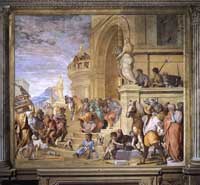 |
Andrea del Sarto, Triumph of Caesar, fresco in Villa Medicea di Poggio a Caiano
|
|
|
|
Franciabigio | The Triumph of Cicero
|
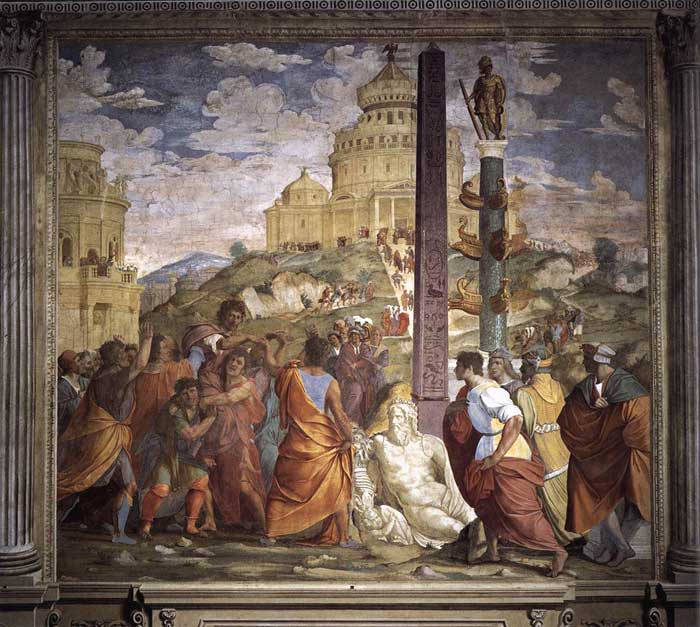 |
Franciabigio, The Triumph of Cicero, c. 1520, fresco at Villa Medicea di Poggio a Caiano
|
Franciabigio enjoyed a close relationship with the Medici. He was the artist given the commission about 1520 by Giulio de' Medici for the entire cycle of frescoes at Poggio a Caiano, which he was expected to divide with Andrea del Sarto and Pontormo. Like Andrea del Sarto, he frescoed one of the larger and more prominent lower fields in the room. His Triumph of Cicero is based on Plutarch in which the 'Pater Patriae', following a period of exile, is carried by a vigorous frieze of figures to the Capitoline reconstructed above in the background - an apparent allusion to Cosimo il Vecchio's return from Milan from his own exile. The fresco takes its place comfortably alongside what are now the more celebrated images by Andrea del Sarto and Pontormo, which together evoke the notion of a Medici Golden Age in an impressive private setting outside Florence. Like Sarto's, this fresco has lateral additions by Alessandro Allori in the right half.
|
Jacopo Pontormo | Vertumnus and Pomona
|
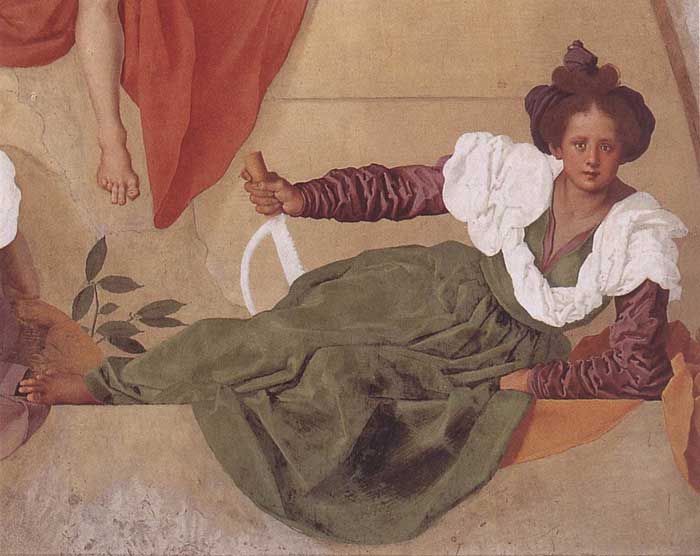 |
Jacopo Pontormo, Vertumnus and Pomona (detail, reclining woman), 1519-21, Villa Medicea di Poggio a Caiano, Poggio a Caiano
|
Pontormo was the son of the painter Bartolommeo Carrucci. According to Vasari, he was apprenticed to Leonardo da Vinci and afterward to Mariotto Albertinelli and Piero di Cosimo. At the age of 18 he entered the workshop of Andrea del Sarto, and it is this influence that is most apparent in his early works.
Influenced by Leonardo da Vinci (1452-1519) and Andrea del Sarto (1486-1531), he worked for the Medici, Borgherini and other families of the Florence Renaissance, making his initial reputation with fresco works at the Medici villa at Poggio a Caiano.
Through the patronage of Cardinal Ottaviano de' Medici, Pontormo painted a famous portrait of Cosimo de'Medici Il Vecchio (1518-19, Uffizi), noted for its rich warm reds, and was then asked to help decorate the great entrance hall of the Villa at Poggio a Caiano. The series, commissioned by Pope Leo X in memory of his father Lorenzo the Magnificent, was carried out by Andrea del Sarto, Franciabigio (1482-1525) and Pontormo, who was responsible for two opposite lunettes pierced by a bull's-eye window (oculus) in the centre. On the death of Leo X the work was left unfinished. Pontormo had completed only one of the lunettes (Vertumnus and Pomona) but it is one of his happier works, a masterpiece of Florentine Mannerism, full of fantasy and elegant arabesques.
The story of Pomona and Vertumnus is the classic Greek mythological love story, however, it is Roman. The main characters of the story are Pomona, a nymph, and her greatest admirer, Vertumnus.[4] |
|
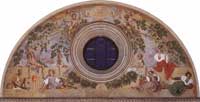
Jacopo Pontormo, Vertumnus and Pomona |
|
|
|
|
| |
|
| |
|
|
|
|
| |
|
Short film in Birth House of Pontormo and the Villa Medicea di Poggio a Caiano, at Poggio a Caiano
|
|
|
The Italian painter Andrea del Sarto (1486-1530) was one of the most important painters of the High Renaissance. His highly expressive use of color is unsurpassed in Florentine painting.
With Michelangelo and Raphael working in Rome, Andrea del Sarto became the leading painter in Florence following the death of Fra Bartolommeo in 1517, and through his pupils, II Rosso and Pontormo, he was a vital formative influence on the development of mannerism.
Andrea was born in Florence on July 16, 1486. He was the son of Agnolo di Francesco, a tailor (Italian, sarto), hence the name Andrea del Sarto. According to Vasari, who was a pupil of Andrea, he was trained with a goldsmith from the age of 7. An earlier source identifies Andrea's master, quite convincingly, as Rafaellino del Garbo, a highly competent and successful painter of the late 15th century. About the age of 20 Andrea set up an independent shop with Franciabigio, although he did not matriculate in the painters' guild until Dec. 11, 1508.
Early Period
In 1509 Andrea received his first important public commission for five frescoes in the entrance cloister of the Church of SS. Annunziata, Florence, depicting scenes from the life of St. Filippo Benizzi. Two further frescoes, the Journey of the Magi and the Nativity of the Virgin, added in 1511 and 1514, illustrate the very rapid development of his style. Of the panel paintings, the beautiful Mystic Marriage of St. Catherine (ca. 1512; Dresden) shows his deep understanding of Leonardo's art, particularly in the expressive and compositional use of chiaroscuro (light and shade). Andrea was very selective in the ideas and motifs that he derived from his great contemporaries Fra Bartolommeo, Michelangelo, and Raphael. His figures are not idealized but warmly human and even humorous. He showed a notably early interest in Northern woodcuts by such artists as Albrecht Dürer, Martin Schongauer, and Lucas van Leyden; and his interest in sculpture was not confined to the antique but extended to the use of actual models by his friend Jacopo Sansovino, with whom he shared a workshop from 1511 to 1517.
Middle Period
Between 1511 and 1526 Andrea painted the famous monochrome fresco cycle in the cloister of the Scalzo, Florence, which is one of the masterpieces of High Renaissance art. The elaborate, painted architectural setting and the sculptural clarity of the narrative established new standards in monumental fresco painting.
Outstanding among the panel paintings of this period are the Madonna of the Harpies (1517; Florence) and the Wallace Madonna (1517-1518; London). In these mature works the outward gaze of the saints and the compelling vibrancy of the color demand the devotional involvement of the spectator.
It was probably in 1517 that Andrea married Lucrezia del Fede, a widow, whose portrait he had included in the Nativity of the Virgin. Despite Vasari's condemnation, which was so readily accepted and elaborated in the 19th century, there seems to be no real evidence that Andrea suffered either moral or financial ruin as a result of this marriage.
Summoned by the French king, Francis I, he traveled to France in 1518, but his stay at Fontainebleau was very short for he was back in Florence by the autumn of 1519. The Charity (Paris) and the Portrait of a French Lady (Cleveland) are the only surviving paintings that he executed in France.
Andrea may have visited Rome in 1519-1520 in connection with the important commission from Pope Leo X for the decoration of the Medici villa at Poggio a Caiano, near Florence, since Andrea's fresco Tribute to Caesar (dated 1521) at the villa strongly suggests a direct experience of Raphael's work in Rome.
Late Period
Comparatively little is known of the later part of Andrea's life, although his presence is frequently documented in Florence and his paintings offer no real evidence of any extensive travels. In 1520 he purchased a site on the Via della Crocetta and built a house. In 1524 Andrea took his family to the Mugello to avoid the plague. There he painted the Pietà (Florence), which, though more restrained in its color and emotion than the earlier Pietà (ca. 1520; Vienna), forms the point of departure for the deliberately appealing beauty of the late works. The increasing idealization and the sometimes arbitrary but acutely expressive color of paintings such as the Quattro Santi (1528; Florence) and St. Agnes (1527-1528; Pisa Cathedral) provided a rich source of inspiration for the young generation of mannerist painters. Yet the powerful devotional feeling in these works is evident from the exaggerated praise that Andrea received from writers of the Counter Reformation.
He died of the plague on Sept. 29, 1530, and was buried by the religious confraternity of the Scalzo in the Church of SS. Annunziata.
His Character
Andrea seems to have been a kindly, unassuming man with high professional standards and a profound understanding of humanity. He was genuinely pious, sometimes working for a nominal fee or, as in the case of the Madonna del Sacco (SS. Annunziata, 1525), waiving his fee altogether. Vasari interprets this as timidity and weakness, but it is more likely that Andrea, who was patronized by the Pope and the King of France, was sufficiently prosperous to afford such generosity. His popularity in the 16th century is demonstrated by the survival of an exceptional number of copies of his works.
Commonly referred to as Andreino, he was short of stature, as noticeable in the self-portrait in the Journey of the Magi (SS. Annunziata). The most reliable record of his features is the self-portrait painted on a tile (1527-1528; Florence).
Franciabigio (1482 – January 24, 1525), was an Italian painter of the Florentine Renaissance. His true name may have been Francesco di Cristofano, however he also is referred to as either Marcantonio Franciabigio or Francia Bigio. He was born in Florence, and initially worked under Albertinelli until about 1506. In 1505 he befriended Andrea del Sarto; and by the next year, the two painters set up common shop in the Piazza del Grano. He was proficient in fresco and Vasari claimed that he surpassed all his contemporaries in this method. It however in his portraits, and not religious paintings and frescoes, that his painting gathers naturalistic power. In 1513, in the cloister of the Annunziata he frescoed the Marriage of the Virgin, part of a larger series mainly directed by Andrea del Sarto, and overshadowed by the latter's masterpiece of Birth of the Virgin[1]. Other artists working under Sarto at the cloister included Rosso Fiorentino, Pontormo, Francesco Indaco, and Baccio Bandinelli[2]. In 1514, he frescoed a Mategnesque Last Supper for the Convento della Calza in Florence[3]. In 1518-19, at the Convento della Salzo, in another series of frescoes on which Andrea was likewise employed, he executed the Departure of John the Baptist for the Desert, and the Meeting of the Baptist with Jesus. In 1520-21, at the villa Medici at Poggio a Caiano he frescoed a turgid Triumph of Cicero on the walls of the salon, but again he is overshadowed by Potormo's naturalistic lunette of Vertumnus and Pomona. The array of figures appears distraught rather than celebratory, the antique details are a melange of quotations, and the architect a fancy of Quattrocento style[4]. He painted a St Job altarpiece (1516, Uffizi). Various works which have been ascribed to Raphael are reasonably deemed to be by Franciabigio. Such as the Madonna del Pozzo, with its awkwardly muscular John the Baptist[5]; and some of his portraits, including the half figure of a Young Man (shown above). These two works show a close analogy in style to another in the Pitti gallery, avowedly by Franciabigio, a Youth at a Window, and to some others—which bear this painter's recognized monogram. The series of portraits, taken collectively, placed beyond dispute the eminent and idiosyncratic genius of the master. Two other works of his, of some celebrity, are the Calumny of Apelles, in the Pitti Palace, and the Bath of Bathsheba (painted in 1523), in the Dresden gallery.
Critical assessment and legacy
When compared to his younger contemporary colleague, del Sarto, Franciabigio appears more sculptural and less forward-looking. The Quattrocento monumentality (or stiffness) of posing is evident in figures. Franciabigio attends more to linearity and balance in fresco recalling Massacio, while the complexity and Sarto's paintings reflect an understanding of the dissipating velvety colorful fabric of molding that characterizes Venetian work, and the development of sway that will "mannerize" art in the decades to come.
|
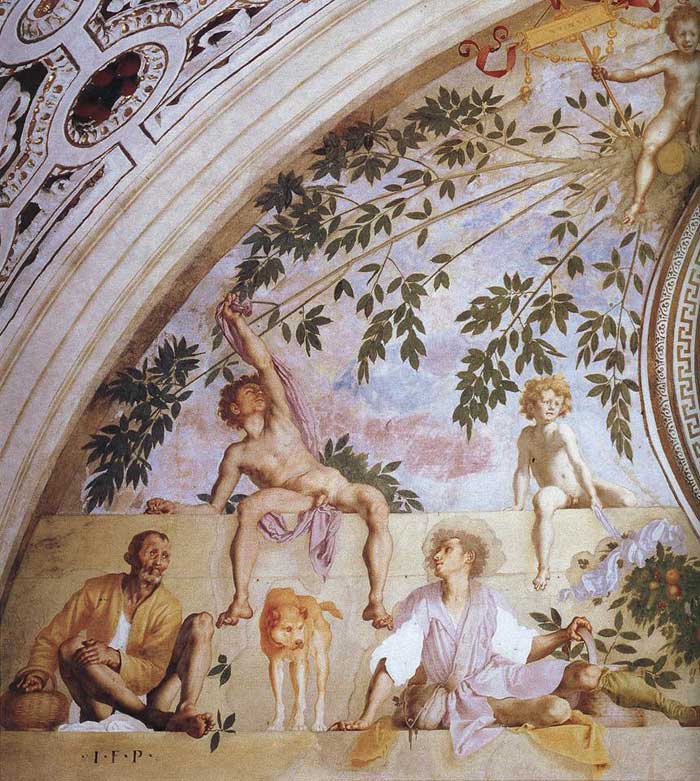 |
Jacopo Pontormo, Vertumnus and Pomona (detail), 1519-21, Villa Medicea di Poggio a Caiano, Poggio a Caiano
|
The painter Pontormo (1494-1556) was an innovator of the mannerist style whose works influenced the subsequent development of Florentine mannerism.
Pontormo whose real name was Jacopo Carrucci, was born at Pontorme near Empoli. Apprenticed in rapid succession to several painters, including Leonardo da Vinci and Piero di Cosimo, when he was about 18 Pontormo became an assistant to Andrea del Sarto. Pontormo's first big commission, a fresco, the Visitation (1514), in Saints Annunziata, Florence, was part of a cycle of scenes from the life of Mary to which Andrea also contributed; it was such a success in Andrea's style that it aroused his jealousy.
The break with the classical style of the High Renaissance came about when the skill in realistic rendering had apparently reached a point in the work of Leonardo and other artists that could not be surpassed. Andrea and his contemporaries rearranged these realistic observations in handsome compositions which thus tended toward academic schemes, smooth and idealized. Andrea's pupils, in turn, formalized these patterns at one remove from nature. The mannerist artist emphasized the figure, as earlier High Renaissance painters had done, but he distorted its proportions and its relationship to space.
Pontormo's Visitation presents grandly robed, symmetrically grouped people in a niche, much as Andrea had done in his art, but in a series of small paintings of Joseph in Egypt (1515-1518) Pontormo scattered the figures over the picture surface, whimsically linked by impossible staircases. In the altarpiece (1518) for St. Michele Visdomini in Florence, black shadows separate the people and hide any spatial coordinates, and in the lunette fresco (1520) of the Medici villa at Poggio a Caiano, depicting the pastoral myth of Vertumnus and Pomona, the figures sit and gaze at us, making no gesture that links them in a narrative. All the figures are convincingly modeled, and his countless figure drawings are brilliant.
Of Pontormo's Passion frescoes (1523-1524) in the Certosa of Galluzzo, Christ before Pilate is the most famous. The figures, influenced by Albrecht Dürer, are sharply elongated, and the receding space is titled almost vertically upward. The Deposition altarpiece (1526) in St. Felicita in Florence is the climax of the artist's career, a mound of rising figures in odd shades of pink and green, each crisply drawn. This painting is a masterpiece of early Florentine mannerism.
Little of Pontormo's late work has been preserved. In the 1530s he painted stylized portraits and works closely derived from Michelangelo, another phase of the use of completed art as a tool that is basic to mannerism. Pontormo's last frescoes (1546-1556; destroyed), in St. Lorenzo in Florence, executed with a new style of fluid line, were generally disliked. He died in Florence in late December 1556.

Comune di Poggio a Caiano | Historical and touristic guide of Poggio a Caiano
Poggio a Caiano is located at the intersection of straight lines from Florence to the city of Pistoia, and from the city of Prato and to Montalbano.
From the hill that gives the town its name ("poggio" meaning "knoll" in Italian together with the family name "Caius" or "Caia") there is a fine view over the plain of the Ombrone and Bisenzio rivers toward Prato to the north and Florence to the east, and over the lowlands leading to Pistoia and the Appenine mountains.
It was not by accident that Lorenzo de' Medici chose this site to build his Villa, the building which is still the most dominant in the town, to the point that the one is always identified by the other.
Art in Tuscany | Andrea del Sarto
|
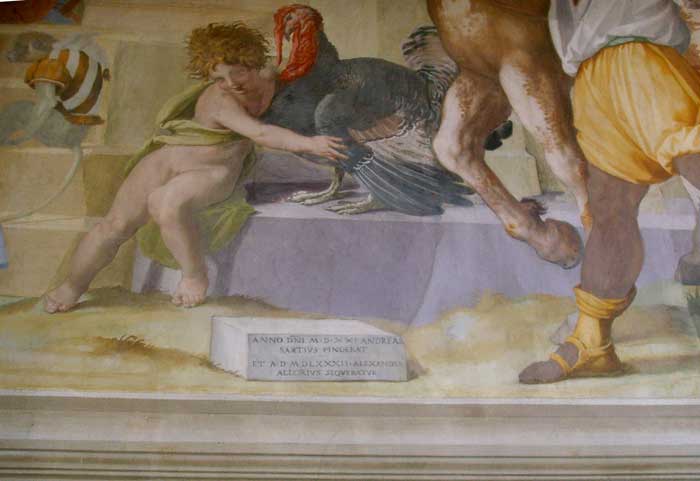 |
Fresco by Alessandro Allori and Andrea del Sarto (the signature) in Villa medicea di Poggio a Caiano, inside sala di Leone X
|

|
[1] Lapi Ballerini The Medici Villas, 2003
[2] C.G.F. Young The Medici
[3] Roberta Passalacqua La Villa medicea di Poggio a Caiano, 2000
[4] Pomona and Vertumnus
The story of Pomona and Vertumnus is the classic Greek mythological love story, however, it is Roman. The main characters of the story are Pomona, a nymph, and her greatest admirer, Vertumnus.
Pomona was the only nymph who did not love the woods. She prefferred gardens, and so that is where she stayed and that was the only thing she cared about. Pomona was very beautiful and and many admirers. Her greatest admirer was a man name Vertumnus. However, Pomona cared nothing of these men and only for her garden.
Vertumnus, being Pomona's greatest admirer, could not go a day without seeing her. He would continue to disguise himself as a different personality every day just to go look upon her beauty without her recognizing him. She grew more beautiful each time he saw her, until finally, looking wasn't enough.
Vertumnus devised another plan in which he would make her not only allow him to see her, but her to love him as well. He disguised himself as an old woman and went to see her to sell her fruit. When he saw Pomona admiring the fruit, he said to her, "But you are far more beautiful." With that statement, he kissed her.
Vertumnus continued to kiss Pomona and she started thinking this was a little strange. Seeing her suprise, Vertumnus stopped and tooke a seat across from her. He looked at the a grape vine near him. Vertumnus cleverly used a metaphor with the grape vine, saying it would not be as beautiful if it were not for the grapes. He was of course, getting at the fact that Pomona was missing a man in her life. Then he went on saying that the Roman goddess of love, Venus, hated hard-hearted women like Pomona.
Vertumnus took one last look at Pomona, and using the metaphor of the grape vine again, told her that she could not stand alone and should love Vertumnus. For Vertumnus had loved Pomona, and would never love anyone else. Also, he would love her garden too. With this, Vertumnus rose and shed his old woman disguise, revealing himself to Pomona. Pomona rushed into Vertumnus's arms, and since then, Pomona's orchard has had two gardeners. |
[5] Eleanor of Toledo (Italian: Eleonora di Toledo (1522 – 17 December 1562), born Doña Leonor Álvarez de Toledo y Osorio, was a Spanish noblewoman who was Duchess of Florence from 1539.[1] She is credited with being the first modern first lady, or consort. She served as regent of Florence during the absence of her spouse.
Eleanor was born in Alba de Tormes, Salamanca as the second daughter of the Viceroy of Naples, Don Pedro Álvarez de Toledo, Marquis of Villafranca (Charles V's lieutenant-governor) and Maria Osorio, 2nd Marquise of Villafranca.[2] Her father was the second son of Fadrique Álvarez de Toledo, 2nd Duke of Alba and therefore, the third Duke of Alba was his eldest brother.
Eleonora di Toledo became the wife of Cosimo I de' Medici, the ruler of Tuscany, whom she married in 1539. The new couple had a large gathering at the Medici Villa in Poggio a Caiano to celebrate the nuptials. Her father demanded that Cosimo settle a large amount of money on her as her dowry, but as the Medici were new to their ducal status, the marriage was attractive for a variety of political and dynastic reasons. Eleonora's royal Castilian ancestors and relations with the Habsburgs provided the Medici with the blue blood they had hitherto lacked and began the process of placing them on a footing with other European sovereigns.[3]
Through her father, Eleonora also provided the Medici with a powerful link to Spain, at that time ultimately in control of Florence, so that the marriage offered Cosimo I the opportunity to show sufficient loyalty to and trust in Spain that Spanish troops could be withdrawn from the province. |
|
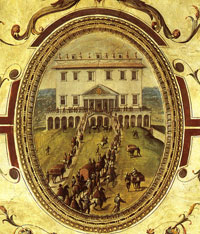
Giovanni Stradano "Eleonora da Toledo reaches Poggio a Caiano from Naples for her marriage " - Florence Palazzo Vecchio |

Located on the outskirts of Castiglioncello Bandini, Podere Santa Pia is one of the best places to slow travel in southern Tuscany. offers the quiet tranquility of a private retreat, with numerous attractions, beautiful nature reserves and unspoilt beautiful beaches within easy reach.
Explore the medieval hillside villages of Sovicille, Civitella Paganico and Monticiano on your way to Siena, watch the Ponte della Pia near the Eremo di Rosia and marvel at settlements that date back to Etruscan times, try some Vino Nobile wines in Montepulciano, or Brunello in Montalcino, cities where the refined beauty of the squares and churches blends perfectly with the ancient traditions of its red wines.
Hidden secrets in Tuscany | Holiday house Podere Santa Pia
|
|
|
|
|
|
|
|
|
|
|
Podere Santa Pia |
|
Podere Santa Pia, view from the garden
on the valley below
|
|
Montalcino, forttress |
| |
|
|
|
|
| |
|
|
|
|
Other villas in Prato
Villa Medicea la Ferdinanda in Artimino
This imposing villa, which Ferdinand I commissioned Buontalenti to design, came to been also as "La Ferdinanda" and as the "Villa of the Hundred Chimneys" because of its many, variously-shaped chimney stacks. Originally conceived by Ferdinand as a hunting lodge, the building has a highly elegant and apparently simply-designed exterior, in a style typical of the Florentine Renaissance. The front of the villa is noted for the visually striking double flight of steps leading up to the entrance; the two angular avant-corps that protrude from the sides of the building create something of a fortress feel. The interior of the villa has fifty-six lavishly decorated rooms. The property passed from the Lorraine to the Maraini family, and is now owned by a private company, which uses it for congresses, conventions, ceremonies, and other events of a cultural nature. Since 1983 the basement has housed Artimino's Municipal Archaeology Museum, set up to bring together the numerous archaeological finds from the Carmignano area, mostly from ancient Etruscan settlements.
|
This article incorporates material from the Wikipedia articles Andrea del Sarto, Eleanor of Toledo and Poggio a Caiano, published under the GNU Free Documentation License.
Wikimedia Commons has media related to Villa Medicea in Poggio a Caiano.
|
|
|
